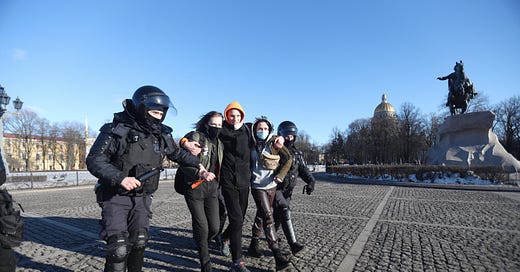
One strange thing about Russia’s invasion of Ukraine is that there wasn’t much of a propaganda push on its behalf, either at home or abroad. On February 21, days before the invasion started, Putin gave a long, tedious speech that was a partisan and dishonest history lesson, a long airing of grievances about how Russia had been wronged by various parties and Ukraine had no independent national identity. While this was a pro-war speech, it was not a rousing one: it seemed like the goal was not to incite belligerent ecstasy so much as to bludgeon the population into dutiful acceptance of the conflict’s inevitability.
Putin seems to have thought that mobilizing the population wasn’t necessary, that he would have quick military victory which would be accepted by Russians and the world as a fait accompli.
That plan has gone badly awry. Ukrainian resistance has been strong, there’s been universal condemnation (including a lopsided UN votes of of 141 countries voting for a resolution condemning the invasion, with only 5 countries rejecting the resolution and 35 abstaining). Moreover, there’s been protests against the war in dozens of Russian cities, with more than 13,000 arrests made.
In response to these changes, the Russian government has prodded its allies to release a torrent of propaganda in support of the war. These propaganda messages often excoriate the anti-war movement, which seems to be worrying Putin. I wanted to look at some examples of propaganda which offer an important window into the war. They clarify the extent to which Putin feels the need to go beyond the historical and legal argument of his original speech and make a wider pitch to the forces of traditionalism and jingoism.
First, the Russian Orthodox Patriarch Kirill has come out in support of the war.

In his statement, Kirill conjured up a conspiracy of the West to impose gay pride parades upon the whole world. “Pride parades are designed to demonstrate that sin is one variation of human behavior,” Kirilll said. “That's why in order to join the club of those countries, you have to have a gay pride parade.” The theocratic arguments made here aren’t always present in Putin-style nationalism. The theocrats have to be understood as a a faction of the nationalist coalition. In framing the war in homophobic terms, Kirill is trying to position his church as central to the nationalist project.
And, second, an assortment of Z Rants.
In what might to be an organic development the Latin letter Z (which doesn’t have a counterpart in the Cyrillic script alphabet) is starting to be used as an identity badge by Russian soldiers and war supports. This seemingly the last few days, there have been a host of videos featuring Russians supporting the war wearing shirts with the Z marker.
These videos themselves are the earmark of government propaganda rather than the work of individuals (they feature large crowds wearing the same outfit). In one video, a young man gives a rant:

The special operations [i.e. the war] by Russia in Ukraine is the consequence of the death of more than 14,000 people in Donbas, 150 of them innocent children, in others, a direct military threat to our country. Today, our army, like during WW2, is again clearing Europe of Nazism. Our mission is to help the government carry out their sacred mission and not interfere, but to support them and raise morale. At this time, in our country, people posing as innocent citizens, it shames me to say, are telling people to come to protests. The streets of Russian cites are the source of the strength of our military and we promise that we will not leave them undefended. This mission will succeed, whether you like it or not. Speaking to all our soldiers – keep working, brothers, and be assured that you are heroes to us. FOR RUSSIA! FOR THE PRESIDENT! [chanting of wider group] (Translation by Twitter user @vegadrien)
Here's another tirade along the same lines:

In both rants, the targets of abuse are anti-war protesters as well as Ukrainians. In the second protesters are called saboteurs, suggesting they have sinister motives. Both draw on the memory of the Second World War for inspiration (the second rant alludes to the siege of Leningrad), evoking both the need for national unity and the allegedly fascistic nature of the enemy. The Great Patriotic War, of course, was formative to Soviet nationalism and remains a potent inspiration in Russia.
These videos are strongly authoritarian and carry the threat of violence. They are goonish propaganda. They suggest that anti-war protesters could soon face not just arrest but also violence at the hands of counter-protesters. Stirring up this sort of domestic political violence might not have been Putin’s intentions from the start, but by invading Ukraine he’s opened up Pandora’s box. All sorts of monsters are now flying out.
(Edited by Emily M. Keeler; translation assistance by Robin Ganev)
Share and Subscribe
If you enjoyed this post, please share:
Or subscribe:



